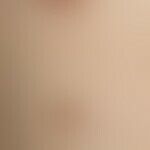Synonym(s)
DefinitionThis section has been translated automatically.
Supernumerary nipples, also called polythelia or hyperthelia, occur in most cases along the embryonic "milk line", which leads from the axillae via the breast and abdominal region, the groin region to the proximal inner thigh.
In rare cases, accessory nipples are also found on the neck, back, buttocks, in the axillary region and on the vulva. An intraareolar occurrence of a second or more nipples is very rare. For cosmetic reasons, surgical methods are recommended for this localization (Cherubino M et al. 2014).
S.a. Mamma, accessory.
Occurrence/EpidemiologyThis section has been translated automatically.
The prevalence is given as 0.2%-5.6% (Galli-Tsinopoulou A et al. 2014).
You might also be interested in
ClinicThis section has been translated automatically.
Soft, 1-2 cm, brown, pelted plaque with central, pointed conical papule. The described structure, resembling the areola, may be modified in many ways. A halo may be absent, as may the central warty papule.
HistologyThis section has been translated automatically.
TherapyThis section has been translated automatically.
Progression/forecastThis section has been translated automatically.
In principle, accessory nipples can be classified as simple and harmless atavisms. Patients should also be advised in this way.
Very occasionally, polythelias in combination with anomalies of kidneys and urinary tract have been observed. Furthermore, associations with genodermatoses (Cohen PR et al. 1995) have been described (in a few isolated cases). In cases of such (complex) malformation syndromes, an increased risk of solid tumors is described. The occurrence of
adenocarcinomas of the kidneys, testicular carcinomas, carcinomas of the prostate and carcinomas of the urinary bladdershould be noted.
LiteratureThis section has been translated automatically.
- Camacho F et al (1998) Polythelia pilosa: a particular form of accessory mammary tissue. Dermatology 196: 295-298
- Casey HD et al (1996) Familial polythelia without associated anomalies. Ann Plast Surgery 36: 101-104
- Cherubino M et al (2014) A Novel Surgical Technique to Correct Intrareolar Polythelia. J Breast Health 10:181-183.
- Cohen PR et al (1995) Miscellaneous genodermatosis: Beckwith-Wiedemann syndrome, Birt-Hogg-Dube
- syndromes, familial atypical multiple mole melanoma syndromes, hereditary tylosis, incontinentia pigmenti, and supernumerary nipples. Dermatol Clin 13:211-229.
- Galli-Tsinopoulou A et al (2014) Polythelia: simple atavistic remnant or a suspicious clinical sign for investigation? Pediatric Endocrinol Rev 11:290-297.
- Hrabovszky T (1995) Accessory breast tissue in the axilla. dermatologist 46: 576-578
- Lewis EJ et al (1998) Report of a nipple nevus and an overview of accessory mammary tissue. Cutis 62: 243-246
Disclaimer
Please ask your physician for a reliable diagnosis. This website is only meant as a reference.







